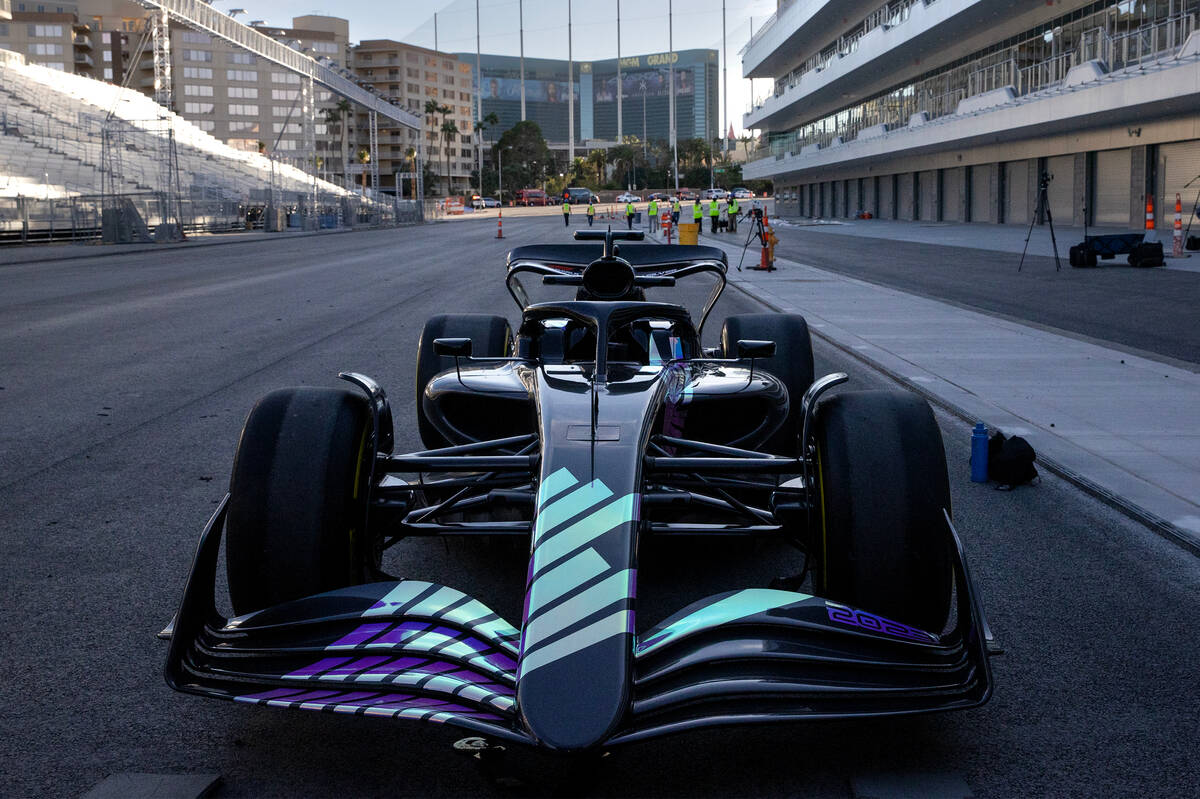Las Vegas Grand Prix turns to technology to minimize water use
Las Vegas Grand Prix officials are turning to an innovative water conservation program in an attempt to minimize Formula One’s environmental effects on Southern Nevada.
Race officials plan to install an atmospheric water generator at the MGM Grand, which is located just southwest of the F1 Pit Building. It will be used to leverage the high relative humidity generated from a commercial cooling tower at the hotel during the race.
Commercial cooling is the second largest water consumer in Las Vegas, according to race organizers.
Over the next few weeks ahead of race week, a pre-pilot phase will be carried out to install the water generator and monitor its performance as it converts the “plume” of moist air released from the cooling tower into water.
The clean, humid air is drawn into the device and put through multiple air filters, then processed through a heat exchanger, where the vapor is condensed into unfiltered water. From there the water goes through a series of filters and a UV lamp sterilizer, which converts the liquid to purified water that is sent out a valve as drinkable water.
The initiative plan will be carried out via a partnership between the Las Vegas Grand Prix, MGM Resorts, the Southern Nevada Water Authority and WaterStart.
“As responsible stewards of resources in the communities where we race, we are honored to partner with our neighbors on this innovative water conservation program,” Renee Wilm, CEO of Las Vegas Grand Prix, said in a statement. “This project not only benefits our home in the Valley but also sets a new aspiration for global motorsports. If successful, the Las Vegas Grand Prix is aiming to become the first Net-Zero Water Consumption race in Formula 1 history.”
Race officials hope the project, once at full scale, will be able to offset water used to carry out the race. Water used to prep the track before the race occurs will be the primary source of water consumption during the Las Vegas Grand Prix.
The timeline for when the project will be considered full scale is to be determined following the initial testing of the system.
The water generators are typically used in remote areas where finding clean drinking water is a challenge. This will be one of the first commercial uses of the technology, according to Pilar Harris, senior director of corporate social responsibility, sustainability and government relations at Las Vegas Grand Prix.
Since the relative humidity in Las Vegas is low, race officials turned to the idea of using resort cooling towers, where humidity levels are high.
“They’re there 24 hours a day, seven days a week, regardless of the season,” Harris said. “Evaporative cooling towers are some of the biggest consumers of water in the valley, that’s not a secret. We thought, ‘What a novel idea to bring an atmospheric water generator to a cooling tower, make them talk to each other, so that the humid air from the cooling tower is captured, filtered through the generator and then spit out as new water.’”
With drought conditions present in Southern Nevada for the past two decades, race officials wanted to show that they are aware of the water issues in the region and are looking to join others in sustainable water management initiatives.
“Given the severity of our drought in Clark County, we always appreciate proactive efforts from private partners to minimize their water use,” Clark County Commissioner Marilyn Kirkpatrick, who chairs the board of directors of the Southern Nevada Water Authority, said in a statement. “This project has the potential to serve as a template for other events held in our community and reaffirming our collective commitment to water conservation in our destination.”
Aside from the planned water conservation effort, grand prix officials are also looking at other ways to make the event more sustainable.
Some of those efforts will take place during race weekend. This includes reducing single-use waste by providing guests compostable cups, plates and utensils; eliminating plastic water bottle use by offering water in canned and glass containers; and instituting a food rescue program to donate food to local organizations instead of it ending up in landfills.
Other efforts involve maximizing energy efficiencies at the Las Vegas Grand Prix Pit Building. That includes using energy efficient lighting, using renewable energy credits, using mechanical cooling, and upcycling materials used in temporary structures for the race to support other efforts in the valley.
“The way we tend to think about sustainability is how we last,” Harris said. “What can we do as a business, as an event or as an experience so that the things that we’re able to accomplish today, we’ll achieve in 10, 20, 30, 40 or 50 years. It’s really about resiliency.”
Contact Mick Akers at makers@reviewjournal.com or 702-387-2920. Follow @mickakers on X.














